Now, I’m sure you will agree with me when I say:
Good water quality and healthy fish go hand-in-hand.
Just one problem – bad quality water and good quality water look identical.
If your water is bad, your fish are suffering. That’s why you need a way to test it. No more guessing!
One of the more popular, and my least favorite, methods of testing water quality is by using aquarium strips.
And today, I am going to teach you all about them.
Contents
What is an aquarium test strip?
If you think back to your science class in high school, you might remember using litmus paper. By dipping the paper into a solution, the paper changed color according to whether it was a base or an acid.
Well, this is an aquarium test strip. And, it works very similar to the litmus paper you used in high school.
Located along the test strips are small, color-changing pads. Each one of these pads is designed to detect a certain water parameter, such as pH or nitrates – allowing you to easily determine your water quality at a glance.
Using a test strip is easy. Simply dip the strip into your aquarium, pull it out and compare the colors of the pads to the color chart. Yep, it’s that simple. If you can’t picture this in your head, don’t worry. I’m going to show you how to use a test strip, step-by-step, later in this guide.
The number of pads on the test strip determine the amount of water parameters you can test for. A test strip capable of testing for 5 water parameters is called a 5-in-1 test strip. A test strip that can test 6 water parameters is a 6-in-1 test strip…. and so on. You get the idea!
But test strips are good for only a single test. You cannot reuse them. Fortunately, they come in packs of 25 or 100, which should last for some time.
In the guide today, I am going to showcase the API 5-in-1 Test Strips that test for, you guessed it! 5 different parameters…
For the most part, these test strips check the water parameters any beginner could ask for…
There’s just one missing…
If you have ever cycled a tank before, you are fully aware of just how important it is to test for ammonia.
However, at the time of writing this, there is no multi-test strip that tests for ammonia. If you want to test for ammonia (and most of you will!), you need to purchase ammonia test strips, like these, separately.
How do you use an aquarium test strip?
Using a test strip is by far the easiest way to test the parameters of your aquarium. In fact, the entire process takes less than a minute.
In this example, I use a test tube filled with water from my fish tank and an API 5-in-1 test strip. However, you can dip the test strip directly into your aquarium.
Step 1: Dip your strip
Grab a test strip, be careful to hold the strip by the end and do not to touch any of the pads. Give it a dunk in your aquarium water, swirling it around a few times.
Step 2: Remove the strip
Remove the strip from the water. The pads on the test strip will change color.
Step 3: Check your results
Now, all that’s left to do is to match each pad with the color chart included with your test strips. And just like that, you have successfully checked your aquarium for most of the important water quality parameters. Simple, huh?
Do aquarium test strips expire?
Test strips are only good for so long. Over time, the reagents in the color-changing pads begin to break down – when this happens, you cannot guarantee that the test results will be accurate.
Just how long the test strips are good for is printed on the packaging…
I bought these in January 2018, and they are good until the end of 2019. So, basically a two-year shelf life, more than enough time to use the 25 test strips.
If the expiration date has passed, don’t use them. A test that cannot guarantee accurate results is useless.
Speaking of which…
How accurate are aquarium test strips?
While test strips can let you know if your water quality is out of whack, I would hardly call them accurate.
The reason test strips are less accurate is the scale they use. Let’s look at the nitrate scale on the API 5-in-1 test strips.
Notice how the readings jump from zero to 20 PPM? That’s a big jump! And, the other scales are similar.
If you want anything more precise than a ballpark figure, test strips are not suitable for you.
Here is how test strips compare to other water-quality testers.
- Test strips – Least accurate
- Liquid test kits – Accurate and affordable
- Scientific meters and probes – Precise but expensive
Can you use test strips to test your water parameters? Absolutely. Should you use them? In my opinion – no.
This is based on my own experience and anecdotal evidence presented by many other experienced fish keepers. Oh, and Amazon reviews seem to agree too!
Which brings me to my next point…
Why don’t I recommend aquarium test strips?
I have been keeping fish for over 30 years now. I used test strips when I started, and I can tell you with a straight face – test strips suck!
Test strips sucked then, and they suck now.
Here are three more reasons why I don’t like test strips…
1. You can’t just test for a single parameter
You know those 5-in-1 test strips? The ability to test 5 different water parameters at once isn’t the blessing that you think.
Want to test just a single parameter? You are going to have to waste an entire test strip.
And despite being made of paper, test strips are like gold…
2. They cost more
To me, this is the biggest reason why I don’t recommend aquarium test strips – financially, they just don’t make sense.
A packet of 100 test strips is going set you back around $30. And, this doesn’t include the ammonia level test strips, which will likely add an extra $10 to the total cost… You can pick up an aquarium test kit like this for half the price!
An aquarium water test kit is more accurate, allows you to test for individual parameters and can be used hundreds of times before it runs out… You can use the money you saved by skipping the tank test strips and buy more fish!
3. Easy to get inaccurate results
As if you needed another reason not to buy test strips… The following can cause your results to be inaccurate.
- Exposure to moisture
- Touching the pads with your wet fingers
- Improper storage
While these can all be overcome, many beginners are unaware that the above can mess with their test results.
Conclusion
If I didn’t make it abundantly clear – I don’t like test strips! They should only be used in an emergency, such as if you are waiting to replace your regular tester.
I feel sorry for the beginners who are suckered into buying aquarium test strips by pushy salesmen, knowing that they will soon return to replace them. Buy a master test kit and save yourself a world of hassle.
Do you use test strips in your aquarium? Let me know in the comments below!

Ian Sterling, founder of Fishlab.com, began his aquarium journey over 30 years ago, driven by a deep fascination for fish and their diverse personalities. His website, Fishlab.com, is dedicated to making fishkeeping accessible and enjoyable, offering beginner-friendly guidance, expert insights, and a community for aquarists to connect and share experiences.


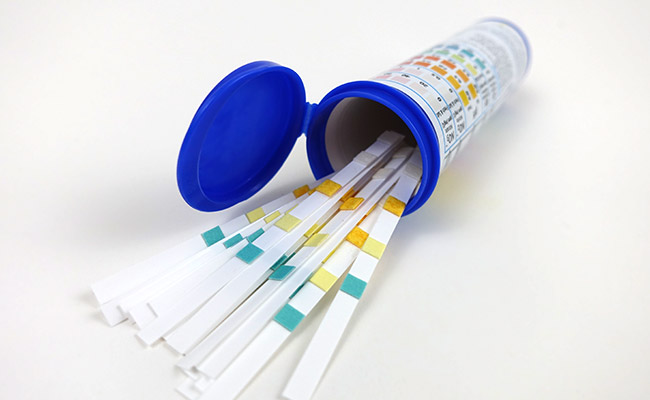

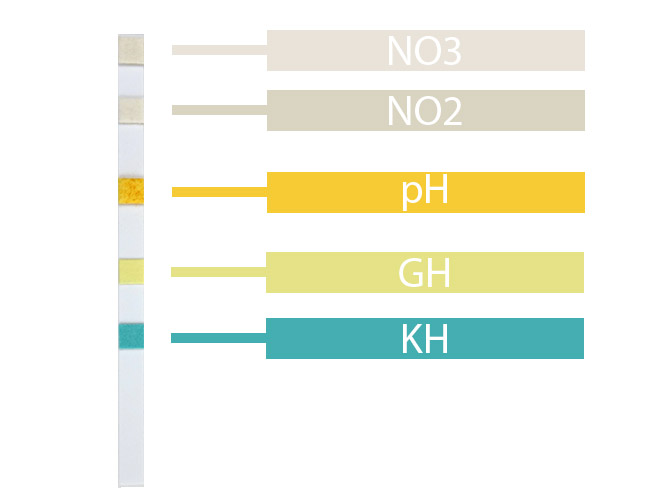
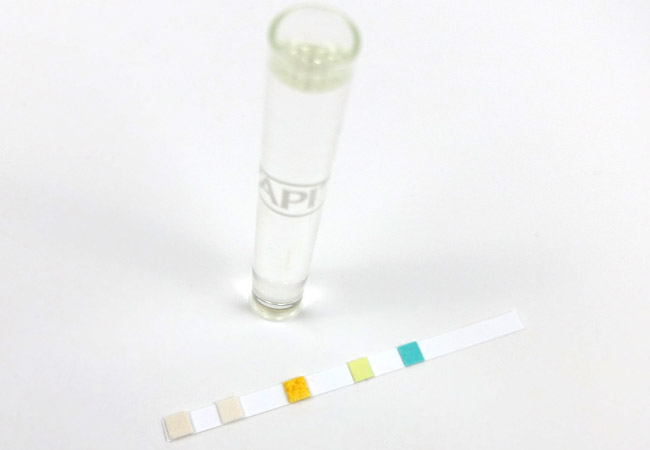
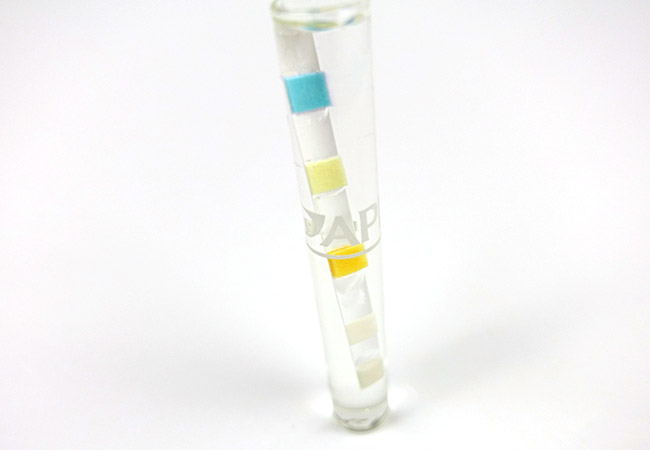
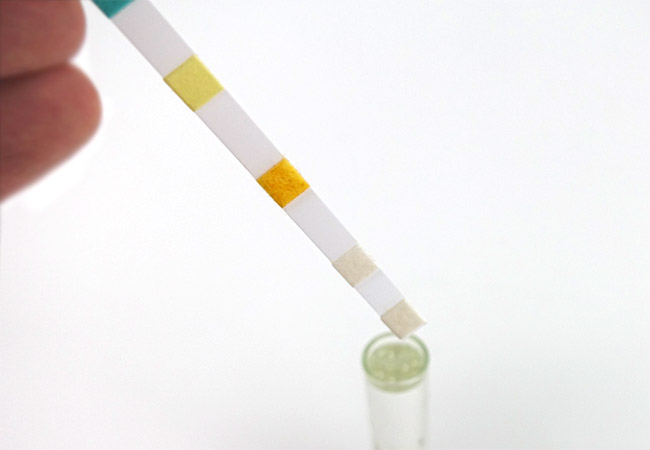
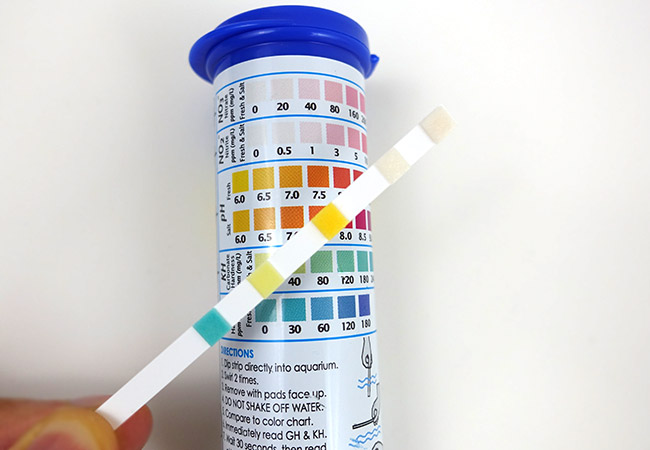
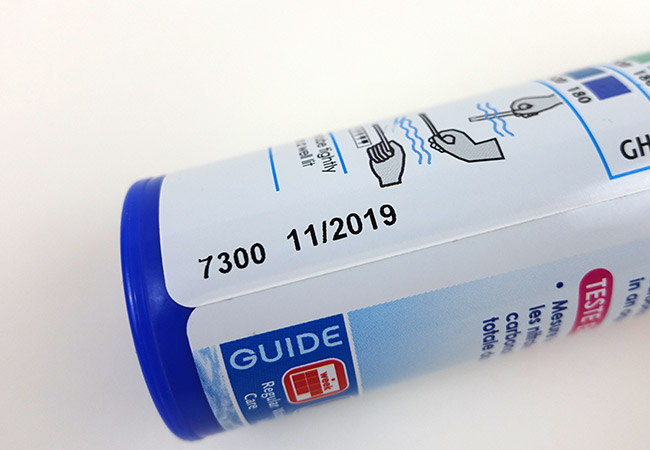
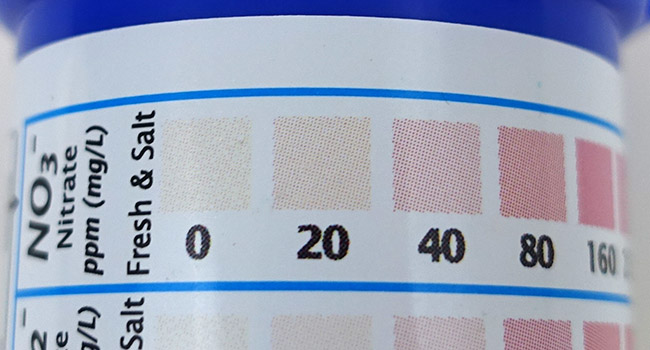
Comments (25)
I use both – I also realize that both have an expiration date and both can give false results. I use the test strips for a quick read -usually before and after a water change. I primarily use them to see that there is indeed a change in my nitrates after a water change.
Hi Robert,
That’s some good advice – the the expiration date can roll around quick and if you are not paying attention, can be using false results to gauge how to act on your tank.
And that’s probably the best way to use aquarium test strips, in addition to a test kit, not instead of. Thanks for the comment!
Thanks so much. My husband and I used to keep many tanks. But life got in the way. I have just set up a 5 gal with 2 feeder goldfish to get back in. Wish me luck. I will be checking in with you for you wise words.
Hi Linda,
Welcome back to the hobby. How exciting! Wishing you all the best of luck this time around.
I have an 8 gallon BioORB that has its own built-in filter which I suspect is inadequate. I have 5 silver neon tetras and one betta in the tank. I did have a cory cat which never seemed to eat and it died. I tried feeding the cory catfish a veggie wafer which disintegrated on the floor of the tank. Before the veggie wafer my water had 0 ppm nitrates or nitrites. After the veggie wafer my nitrates and nitrites and ammonia shot up. I started doing 20% water changes for the first 3 days with a filter change. After day 3 the nitrates and nitrites were still high so I did a 50% water change but left the filter alone to build up bacteria. I spoke to the pet store aquarium guy who said that was wrong and that now my tank would have yo cycle again, and for me to leave it aline so I let about 4 days go by – still have elevated nitrates and nitrites. So I did another 50% water change with added bacteria to help the process along but I am still showing nitrates and nitrites – not as high but still….. HELP ME PLEASE!!!
Hi Carol,
Unfortunately, your tank was never going to have a happy ending. There were too many fish for a tank of that size.
However, here’s where you probably crashed your cycle: you replaced the filter. Beneficial bacteria live in the filter and unless you have specific biomedia such as ceramic rings, changing the filter out will crash your cycle, meaning you have to start over. Those “disposable” filters are a beginner scam and fish often die because of them. A proper filter shouldn’t need to be replaced for years, with minor cleaning along the way.
Unfortunately, the only thing you can do now is perform a fish-in cycle. Check out my fish-in cycle guide for more info.
The GH and KH are mixed up in your diagram. I have that brand strips. The GH is the blue one. Regardless, yeah this suck. How can my GH be second from the highest color and my ph be 6.5? I am trying to keep a 20 gallon tank at work in good condition. I took it over two months ago but had to add a new filter and 50% original water and same gravel and new fake plants. It had 5 established neon tetras. I’ve added 5 zebra danios and 3 otocinclus over the past month and want to add 3 more neons or otocinclus. Yes, there is some green algae on the walls, one plant and the white gravel and yes I do water changes! The tank is finally stable as far as nitrates and ammonia being zero or nearly. But I am concerned about adding the right type of fish now that my ph and gh doesn’t seem accurate. I should probably get the other type of test kit. I hope all the current fish stay well. I did have two guppies that died, probably from low ph.
Hi Kmont,
Thanks for clarifying. Whoops, lucky it doesn’t make too much difference anyway since the diagram is for illustrative purposes.
I’m sorry to hear about your experience. I highly recommend grabbing the API Master Test Kit before making further plans, it will let you know exactly what is happening in your tank. For example, if your ammonia and nitrite read anything other than zero, then something is amiss.
I have a 10 gallon tank with 4 small fish and I cannot get the GH down it’s like at 180 what can I do.
Hi Jose,
Check out my GH guide for more info on this.
My test strip results are all in the normal range for the first 30 seconds or so. But after a couple on minutes the colors have changed and ph level darkens the most after first taking it out of the water. Is it normal for strips to do that as they dry?
Hi Ast,
This could possibly be to the strips drying out/chemical test leaking to the back of the pad/exposure to oxygen etc. I don’t recommend test strips for accurate readings.
Ive used the both salifert test kit for each no2, no3, kh and ph. Comparing to the jbl easy test 6 in 1, it is not that precise but it does give u a glance of how well your aquarium is doing. I do the jbl every week and salifert every month. Or maybe incase the test kit is giving a bad parameters, ill use the salifert to get the actual reading.
Hi Azahari,
That’s a good way to use use test strips, in addition to a test kit. Thanks for sharing your advice!
I use drop tests when I want to create some kind of water, for example a 4°KH water for CO2 permanent test, or if I want to adjust the water hardness of a tank to a given value.
Or when I want to confirm and clarify a bad result from the test strip.
That’s rare enough.
The rest of the time, I think test strips are great ! Quick and easy.
I do not like the smartphone’s app they do nowdays, I find my eyes more efficient, although my phone camera isn’t great at all … That might explains it.
The only thing with test strips is to handle them right so products won’t get spilled one onto the other.
When ever I buy a drop test, the expiration date is always like a year or so, I never can use more than half of it before it expires and sometime the expiration date has been washed out by water spillage … So I have to test the test !! Madness !!
Hi Nathan,
You raise some interesting points. I’m glad you are happy with the test strips!
I have the tetra 6N1 strips and it tests for
– ammonia (separately)
-Nitrite
-Nitrate
-Chlorine (kind of useless cause I use prime during water change and weekly)
-Alkalinity (Kh)
-hardness (Gh)
-Ph
I’ve never realized that strips are bad. But one time I tested for ammonia and found out it was at 6.0ppm. I freaked out and wondered why none of my fish have died. So I went to my LFS and they tested it with the API freshwater master test kit and my ammonia was only at 0.05 (still quite a lot but now its at 0 and no fish deaths)
The only reason I never bought the API freshwater master test kit was because it doesn’t test for Gh, Kh
Hi Tom,
I can see the appeal of these 6-in-1 tests as an all-in-one solution, but they are somewhat of a beginner trap. It sounds like you experienced this first hand with the ammonia scare! You had your head switched on with double checking the tests, imagine what would have happened if you trusted the test and started treating your tank based on these results, you would have unnecessarily stressed your fish.
I use 5 in 1 strips to monitor the PH, GH and KH in my shrimp tank. I use DI water so I have to add KH GH plus to get it where I want it for the plants, shrimp and snails. I find them suitable for my application and they must be accurate enough because my shrimp breed like rabbits.
Instead of testing, once a week I add a cap of ammonia neutralizer. 2 Days Later I add a cap of clarifier and then 2 days after that I add a cap of waste away. I do a 75% water change twice a week and replace additive as needed to adjust for loss in water change. My aquariums are beautiful, fish are thriving and my wallet, heavier and happier!
Hi Dona,
While I’m glad you have found a method that works for you, I highly advise against this. Neutralizing ammonia, does not fix your nitrite issue which, if anything, is more toxic to fish than nitrite. Unfortunately, fish are very good at hiding stress and just because they look “thriving” does not necessarily mean it’s the case. A full aquarium test kit (api) will cost around $20 and last for years. In my opinion it’s negligent to skip it.
Thank you for your Insight. It is something I will consider I do not trust the test strips because I get the same reading on all six tanks. I change one tank and test 3 yet all the results are the same. I have one fish in one tank, two fish in the second tank and five fish in the third tank. I don’t believe there’s any way possible for all the readings to be exactly the same every time. I don’t want undue stress on my fish so I will probably take your advice into consideration and my wallet to the checkout for an inexpensive test kit. Thanks for your input.
I completely agree with your thoughts here, if the tanks and fish are not the same, it would be expected that nitrates would be raising at slightly different rates. I have 4 tanks of different size with various fish and they all read a different nitrate reading at the weekly water change. While you may be completely right and your levels are perfectly fine, it’s much nicer to be confident of the water quality in your tank.
Also, if your readings are all fine, you can skip the ammonia neutralizer. If you are looking for another wallet friendly option, I highly recommend seachem prime as your dechlorinator, it’s ultra-concentrated and goes further than any other dechlorinator I have used (1 ml for every 10 gallons) as a bonus it can neutralize ammonia and nitrite, so it can double as a neutralizer if something ever goes wrong in your tank.
Hello. I have a regular penguine filter with a biowheel attached that was supposed to keep the beneficial bacterial alive but very quickly the throw away filter insert got filled up and the wheel never spun well anyway and now with the water flow the biowheel is not spinning at all. I also have real plants and they may gunk up the filter. I have a sponge to cover where it sucks up water because I have shrimp. I tried getting a bunch of filter media to keep in the filter. They look like small rocks with tiny holes because I want to spend less on throw away filter inserts. I did add another insert of a different brand that has carbon in it because I could not find my brand that fits at the store. I have hear I could use a larger sponge and just wash it. Do I need to keep using carbon? Any suggestions for reusable filter material? I want to save money and be green.
Hi Karissa,
I don’t recommend disposable filters. Every time you throw it away, you are throwing away the good bacteria that keeps your tank safe and healthy. Carbon is only useful for removing tannins and odors – meaning you can likely skip it. Look up aquarium sponge, you cut it to size and when you do water changes, you rinse it in tank water.